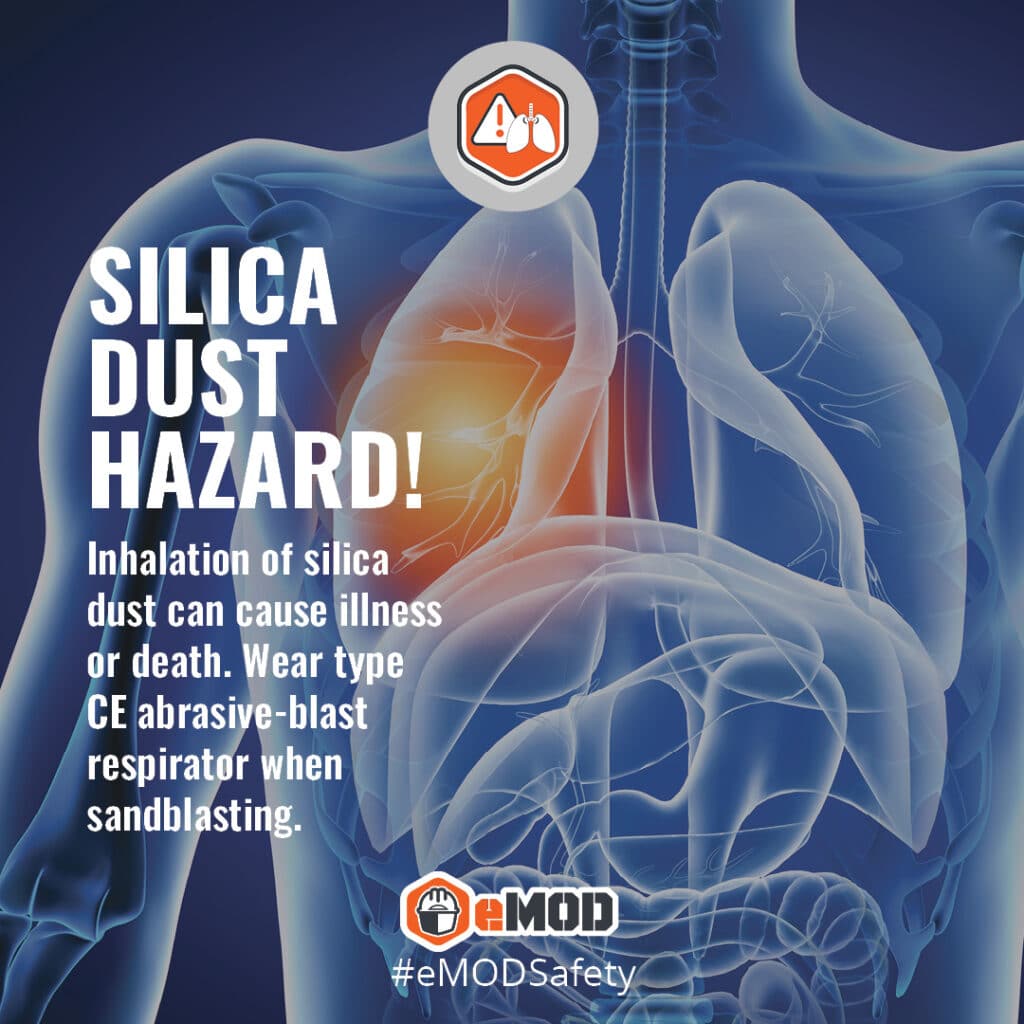
Silica is a word that is often feared in the construction industry. Not only is it detrimental to the moral of a construction site, it’s one of the leading causes of death and serious health issues for our industry. Tracking this deadly particle is an uphill battle for this paper centered industry making companies like eMOD essential to drastically improving safety on the construction site.
Bringing awareness to the importance of properly tracking silica exposure from the very start is something that eMOD allows construction veterans like Dome Construction to confidently and successfully accomplish.
What exactly is Silica?
Crystalline silica is one of the most common minerals on the planet and is found in construction materials such as sand, stone, concrete, brick, and mortar. Silica only becomes dangerous when workers cut, grind, drill, or crush materials that contain crystalline silica, creating very small dust particles.
These particles are very, very small and measure less than 10 micrometers in diameter. That’s about 100 times smaller than regular sand.
Why should we care about protecting ourselves from Silica?
Let’s bring it back to what a construction site used to look like. Walking the jobsite, you’d see a project loaded with dust particles from workers blasting, chipping, cutting, grinding and drilling. But it isn’t just dust you’re seeing and being exposed to, it is a bunch of tiny silica particles.
There would be no respirators on site, no one taking the appropriate precautions to protect their lungs from the harmful silica particles. The idea that the dust didn’t bother them, that they had been doing this for years and there were no signs of health issues, at the time, was enough for workers to not protect themselves.
Little did they know, the constant exposure to the Silica dust was getting deep into their lungs, creating scar tissue, launching a cascade of health issues in the body.
If you don’t protect yourself from the start, this is what COULD happen when Silica accumulates over the years:
- Silicosis – This disease is directly related to inhaling silica dust. As the dust enters into the lungs, it causes scar tissue to form. This tissue makes it hard to breathe properly and get all the necessary oxygen.
There is no cure for silicosis. Since silicosis affects lung function, it makes one more susceptible to lung infections like tuberculosis.
There are 3 types of silicosis:
- Chronic Silicosis: Develops 10 or more years after low-level exposure. Considerable scarring and upper lung symptoms are common.
- Accelerated Silicosis: Develops within 10 years after being exposed to high levels of respirable silica.
- Acute Silicosis: Occurs within a few weeks or years, usually after high-level exposure to respirable silica. Symptoms include fatigue, weight loss and cough.
Silicosis directly causes more than 100 deaths each year.
In the United States, there are 3,600 to 7,300 new cases of silicosis annually
Silicosis is not curable, but it is preventable
The only known treatment for advanced silicosis is a lung transplant – this high risk surgery would cost you $500,000 – $800,000
- Lung Cancer – Silica dust causes the lungs to scar, and this scarring can lead to lung cancer. A person develops lung cancer when abnormal cells multiply in their lungs and form tumors.
- Chronic Obstructive Pulmonary Disease – COPD encompasses several diseases that affect the lungs, the most common of which are emphysema and chronic bronchitis.
- Kidney Disease – In the case of silica exposure, you have a risk of suffering chronic kidney disease, which develops over time rather than suddenly. In some cases, the longer you are exposed to silica, the greater your chance of developing chronic kidney disease is.
Who is most at risk?
Silica exposure remains a serious threat to nearly 2 million U.S. workers, including more than 100,000 workers in high risk jobs.
If you work on a construction site daily, you are putting yourself at risk for silica exposure. However, there are certain tasks that increase your risk of developing serious health issues. This high-risk exposure is a result of certain job tasks, including:
- Tuck pointing
- Abrasive Blasting
- Foundry Work
- Stone Cutting
- Rock Drilling
How has the Industry Responded?
Although the OSHA guidelines came out in 2016 to tighten the restrictions on the amount of silica workers can be exposed to on the job, the industry has struggled with how to implement these new guidelines.
Most companies shifted by swapping out tools and implementing mitigation plans, both very tedious, time consuming adjustments. Navigating the new requirements and understanding how they’d be rolled out proved to be very difficult. There wasn’t a clear plan for training field crews or an understanding of how long it would take the crews to get up to speed with the new requirements.
Implementing a new process challenged the “I’ve done it this way for years” mindset of the field crews. Not only do they need to change the way they are working, but they were required to complete more steps to get the job done. This created an environment where crews felt the pressure to cut corners to gain back their time.
Another hurdle the industry faces is how they are tracking who has been exposed and for how long.
The reason it is so hard to track? Because everything is being tracked on paper. With this process there is no way companies can stay up to date with documenting silica exposure.
Especially when workers are constantly moving from one project to another and the information tracking their exposure lives in binders or in a project folder. The paper tracking process makes it impossible to track who has been exposed and for how long.
Keeping up to date with tools like vacuums and respirators is also a flaw of tracking silica with a paper process. When you aren’t staying up to date with maintaining those tools, you will be putting your crew at a serious risk without even knowing it.
How eMOD is helping companies get ahead of silica
eMOD enables companies to move all safety documents to ONE digital location, making it simple to track silica exposure from the start. This digital process makes it easy to monitor and view documents providing industry leaders such as Dome, the transparency and clarity they’ve never had before.
“With eMOD we can help eliminate the domino effect of health problems that Silica creates.” Chris Reynoso Environmental, Health & Safety at Dome Construction
Training – Anyone who is working with silica receives the correct training through eMOD’s Tool Box Talks. These talks are focused on silica exposure so that the crew out in the field can understand the risk of working with silica and learn new ways to mitigate risk.
Documenting – User certifications – this is ensuring that individuals who are working with silica are properly certified and fit tested prior to work. eMOD helps maintain your certification so you can stay up to date with silica measures.
PTPs – Pre Task Plans – Our Pre Task Plans ensure that the crews out in the field are documenting their proper silica procedures prior to starting work. Our PTPs have been designed to recommend these procedures based on OSHA regulations and procedures.
Protection of your crew – Track your crews silica exposure hours using our eMOD’s in field data to track the hours that each crew member is working with silica. This allows you to track these hours and know when to schedule a recommended doctors appointment.
With eMOD Safety Directors can now see when and how long their crew members have been exposed to silica, down to the exact task they were doing and the amount of time they were exposed. Getting on top of silica exposure from the very beginning is crucial to minimizing the health risks that accumulate over time with consistent silica exposure.
What’s next for your company?
Don’t let another day go by tracking silica the old way and hoping things are being done safely. Schedule a demo with us to check out our new silica tracking tool and learn about other ways you can streamline your safety processes.
Be confident that your team is being proactive in eliminating one of the most harmful things in the construction industry. Learn more about our Complete Safety Platform today.
Sources:

